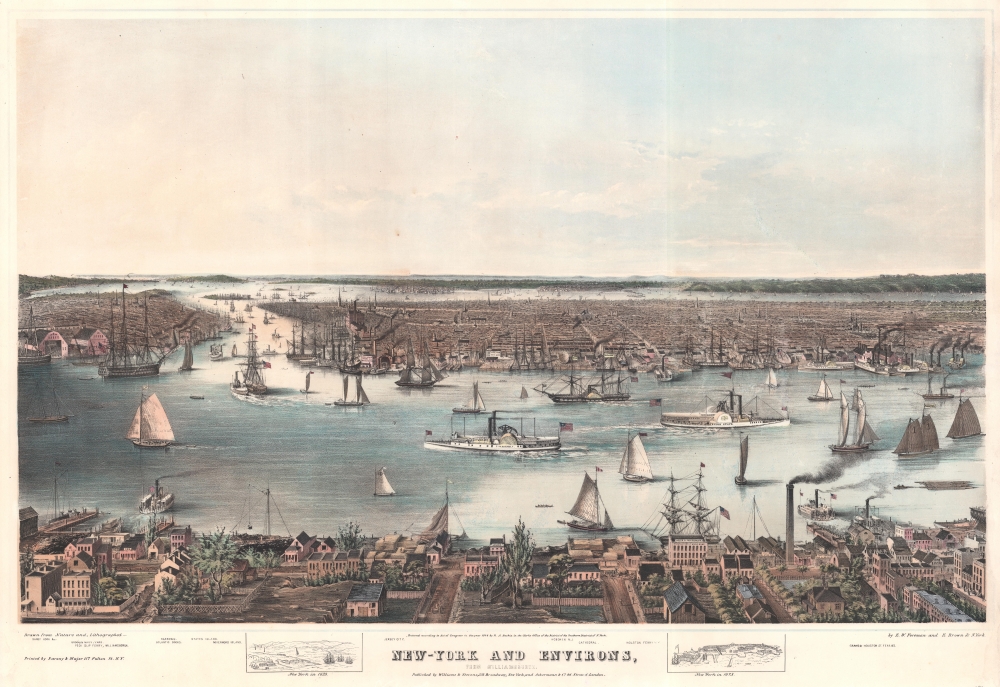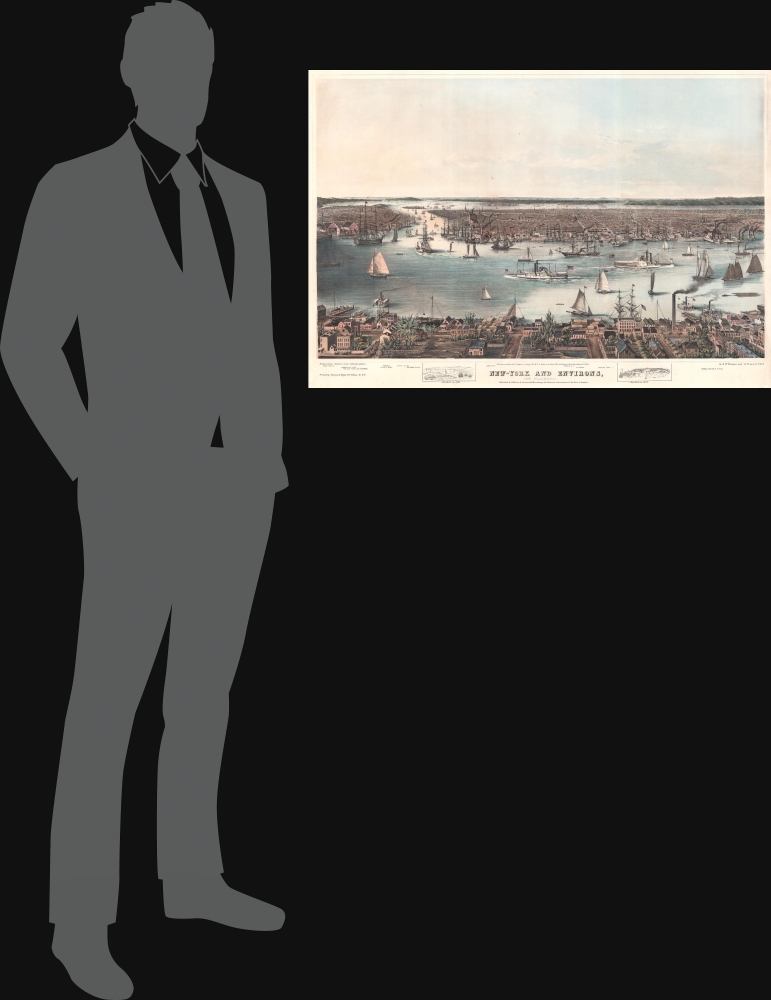1848 Foreman and Brown Bird's-Eye View of New York City from Williamsburg
NewYorkEnvirons-foremanbrown-1848
Title
1848 (dated) 22.5 x 33 in (57.15 x 83.82 cm)
Description
American Bird's-Eye City Views
The Bird's-Eye view industry emerged in the United States in the middle part of the 19th century and coincided with the commercial development of lithographic printing. Before the rise of lithography, the ability to own and display artwork in the home was largely limited to the extremely wealthy, but the advent of lithographic printing made it possible for everyone to own visually striking artwork. A robust trade developed in portraits of political leaders, allegorical and religious images, and city views.City views were being produced in the United States as early as the 1830s, but the genre exploded after the American Civil War (1861 - 1865). Bridging the gap between maps and pictures, most 19th century American bird's-eye views presented cities to the public from highpoints. Some were imagined, but others were drawn from hot-air balloons or nearby hills. The presentation, combining high elevation, commercial interest, and new printing technology created a uniquely American artform, as described by historian Donald Karshan,
Some print connoisseurs believe that it was only with the advent of the full-blown city-view lithograph that American printmaking reached its first plateau of originality, making a historical contribution to the graphic arts. They cite the differences between the European city-view prints and the expansive American version that reflects a new land and a new attitude toward the land.The vogue for bird's-eye city views lasted from about 1845 to 1920, during which period some 2,400 cities were thus portrayed, some multiple times. Although views were produced in many urban centers, the nexus of view production in the United States was Milwaukee, Wisconsin. The major American viewmakers were Stoner, Wellge, Bailey, Fowler, Hill, Ruger, Koch, Burleigh, Norris, and Morse, among others.
Publication History and Census
This view was drawn and lithographed by Edgar W. Foreman and Eliphalet M. Brown, Jr., printed by Sarony and Major, and published by Williams and Stevens in 1848. It was 'entered according to Act of Congress in the year 1848 by R. A. Bachia in the Clerk's Office of the District of the Southern District of N. York'. We note cataloged examples which are part of the collections at the Museum of the City of New York and the New York Public Library. The example at the New York Public Library is colored differently and lacks all the text below the image. However, the image itself is identical. This view appears on the private market occasionally.Eliphalet M. Brown Jr. (1816 - January 24, 1886) was an American daguerreotypist, lithographer, and photographer. He was born in Newburyport, Massachusetts. By 1837, he was working as an artist and lithographer in New York. His name appears on the records of Currier and Ives, among other firms. In 1841 he exhibited at the National Academy of Design, New York. Brown arranged for his younger brother, James Sydney Brown to find a position in the innovative new field of daguerreotype photography. He apprenticed in a gallery owned by Matthew Brady. Both brothers were so impressed with photography that, in 1846, they jointly started a studio, The American Gallery. According to one reference, Eliphalet was an expert lithographer, while James focused on photography. Between 1848 and 1851, Eliphalet left the partnership with his brother and worked with Charles Severyn and, then Currier and Ives. Around this time, he was famously selected to accompany the 1852 - 1854 diplomatic mission to Japan led by Commodore Matthew C. Perry - it is a curiosity of history that Eliphalet, the lithographer, not his brother James, the photographer, was chosen by Perry (who knew them both) as the official expedition photographer. Along the way he took over 400 historical photographs recording the first significant contact between Americans and Tokugawa Japanese. Unfortunately, 6 of these images were lost to an April 11, 1856 fire at a Peter S. Duval Lithography Company in Philadelphia, but contrary to some irresponsible scholarship, most survived. Despite this fact, few are known in institutional and private collections, the remainder presumably consigned to a government archive and simply lost. Others were copied by the artist Wilhelm Heine, who painted them and in partnership with Brown, transferred them to lithographic prints. When Brown returned from Japan, he gave up photography for the Navy Life. He served as a Master and Ensign during the American Civil War. Later he was assigned to the Mediterranean. Brown retired from naval life in 1875, at which time he married and lived quietly until his death in 1886. Learn More...
Napoleon Sarony (March 9, 1821 - November 9, 1896) was a dashingly handsome Canadian-American lithographer and publisher active in New York in the mid to late 19th century. Sarony was born in Quebec and emigrated to New York City in 1835. He apprenticed under Henry Robinson (fl. 1830/33 - 1850) before working as a lithograph artist for Nathaniel Currier (1813 - 1888). In 1846, he partnered with Currier's apprentice lithographer Henry B. Major to establish the firm of 'Sarony and Major.' From offices at 117 Futon Street, they published under this imprint until roughly 1853, when Sarony split off on his own under the imprint 'Sarony and Co.', still at 117 Fulton. At the time 'and Co.' probably meant Joseph Fairchild Knapp (1832 - 1891), Sarony's apprentice, and Richard C. Major, possibly Henry Major's son. In 1857, a new imprint was established as 'Sarony, Major and Knapp'. According to an advertisement in the New York Times (Feb 16, 1864), Sarony had invested in the business at founding, but was not an active partner, possibly because he was traveling in Europe. It is unclear why Sarony's name was maintained, possibly to capitalize on his fame, as a honorific, or possibly because he owned a major stake. They published under this imprint until 1863, becoming a major concern at 449 Broadway. Sarony's name was formally removed from the partnership in 1863. At the time he was traveling in Europe, mastering the most advanced color lithography and photographic techniques. He is known to have worked in France, Germany, and England. He returned to New York in the 1860s, establishing a photography company at 37 Union Square that became famous for its portraits of late-19th-century American theater icons. In 1891, Sarony, hoping to capitalize on Sarah Bernhardt's fame as 'Cleopatra', paid the stage actress 1,500 USD to sit for a photo session, the modern-day equivalent of 20,000 USD - suggesting a highly prosperous business. His son, Otto Sarony (1850–1903), continued the family business as a theater and film star photographer. As an aside, Sarony's second wife, Louie Sarony, was a known eccentric who would reportedly dress in elaborate rented costumes to walk around Washington Square each afternoon. Learn More...
Henry Broughman Major (February 17, 1820 - August 28, 1887) was an American lithographer based in New York in the middle to late 19th century. Major was born in Frome, England and emigrated to the United States in 1834. He apprenticed under Nathaniel Currier (1813 - 1888), befriending Currier lithographer Napoleon Sarony (1821 - 1896). Major worked briefly on his own, or perhaps with his cousin James Parsons Major, from 1845 - 1846 at 10 Watts Street. In 1846 he joined Sarony to found 'Sarony and Major', based at 117 Fulton Street, New York. Henry Major left the firm in 1853 for unknown reasons. At this time, a relative, possibly his son, Richard C. Major, continued to work with Sarony and Joseph Fairchild Knapp (1832 - 1891), creating the firm 'Sarony, Major and Knapp' (1857 - 1863). Learn More...




